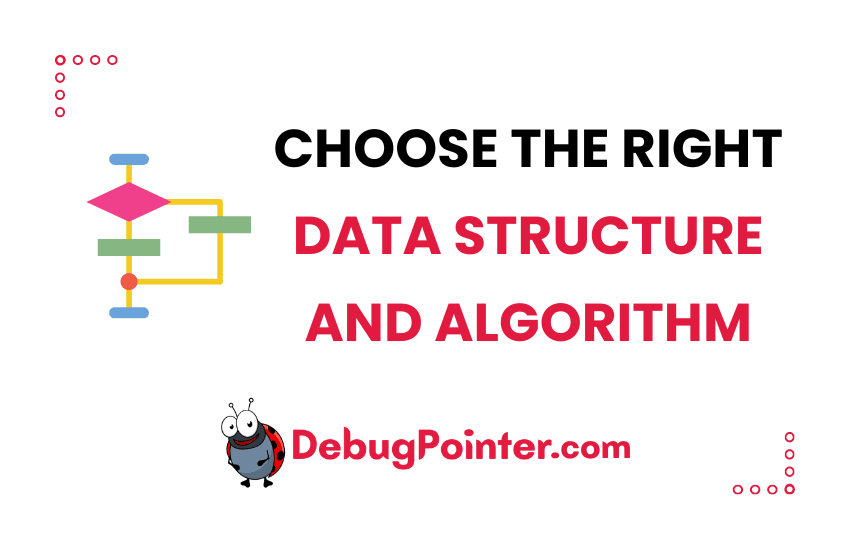Introduction – Choosing the right Data Structure and Algorithm
As a programmer, I’ve learned the importance of selecting the right data structure and algorithm for software development. Making the wrong choices can lead to decreased efficiency, slow execution times, and poor scalability, affecting the overall performance of the software. It can also introduce unnecessary complexity into the codebase, making it harder to understand and maintain, increasing development and maintenance costs.
On the other hand, choosing the right data structure and algorithm offers numerous benefits. It improves code performance, reduces memory usage, and enables efficient resource utilization. With optimal choices, software applications can handle larger datasets and scale smoothly as user demands increase. It also enhances code maintainability and readability, making debugging and collaboration easier for development teams.
Learning and understanding various data structures and algorithms are crucial for preventing performance bottlenecks in code. Familiarity with a wide range of options empowers developers to choose the most appropriate ones for specific problem domains and proactively optimize the codebase. This knowledge fosters a deeper understanding of software development principles and encourages continuous learning and improvement.
In conclusion, choosing the right data structure and algorithm is vital for developing efficient, scalable, and maintainable software. Incorrect choices can lead to issues, while optimal choices lead to better performance and easier maintenance. Investing time in learning and understanding data structures and algorithms enables developers to unlock the full potential of their code and deliver high-quality software.
Choosing the right Data Structures and Algorithms
The choice of data structures and algorithms can significantly impact the performance and efficiency of your code. By selecting appropriate data structures and implementing efficient algorithms, you can optimize your code for faster execution and reduced resource consumption. Here are some key considerations for utilizing data structures and algorithms effectively:
Data Structure Selection
- Understand Data Requirements: Analyze the data requirements of your code to determine the most suitable data structure. Consider factors such as the type of data, the operations you need to perform, and the expected data size. For example, if you need fast insertion and retrieval of elements, a hash table or balanced binary search tree may be more efficient than a simple array.
- Choose Optimal Data Structures: Select data structures that offer efficient time and space complexity for the operations you perform frequently. For example, if you frequently need to search for elements, a hash table or a binary search tree may provide better performance compared to a linear array.
- Avoid Unnecessary Data Structures: Avoid using data structures that add unnecessary overhead to your code. If a simpler data structure can fulfill your requirements without sacrificing performance, opt for the simpler solution.
Algorithm Design and Optimization
- Algorithmic Efficiency: Analyze the time and space complexity of your algorithms. Choose algorithms that have better asymptotic complexity for your specific use cases. For example, if you need to sort a large collection of data, using a more efficient sorting algorithm like Quicksort or Mergesort can yield significant performance improvements over simpler algorithms like Bubble Sort.
- Loop Optimization: Minimize the number of iterations in loops whenever possible. Identify any redundant computations or unnecessary iterations and eliminate them. Look for opportunities to break out of loops early if the desired condition is met.
- Use Memoization and Caching: Apply memoization techniques to store and reuse the results of expensive function calls or computations. Memoization can greatly reduce the execution time of repetitive calculations by caching the results for subsequent use.
- Parallelism and Concurrency: Explore the possibility of utilizing parallelism or concurrency to improve the performance of your code. By breaking down tasks into smaller units that can be executed simultaneously, you can take advantage of multi-core processors and distributed computing resources.
Complexity Analysis and Testing
- Analyze Time and Space Complexity: Perform a thorough analysis of the time and space complexity of your code. Identify sections of code with high complexity and evaluate if they can be optimized further. Aim for algorithms and data structures that offer the best balance between time and space efficiency for your specific requirements.
- Benchmarking and Profiling: Use benchmarking and profiling tools to measure the performance of your code. Compare different implementations, algorithms, or data structures to identify bottlenecks and areas for improvement. Profile your code to identify hotspots that consume significant resources or time.
By leveraging efficient data structures and implementing optimized algorithms, you can significantly enhance the performance and efficiency of your code. Careful consideration of data requirements, algorithmic efficiency, and complexity analysis can lead to faster execution times, reduced resource consumption, and improved overall code optimization.
Conclusion – Why is it important to choose the right Data Structures and Algorithms?
Choosing the right data structure and algorithm is critical for software development, as it significantly impacts performance, scalability, and efficiency. Using inappropriate choices can lead to decreased efficiency, slow execution times, excessive memory consumption, and poor scalability, resulting in a suboptimal user experience. Additionally, it introduces code complexity, making debugging, maintenance, and collaboration difficult, leading to increased development costs.
On the other hand, making correct choices offers numerous benefits. Optimal data structures and algorithms improve code performance, reduce memory usage, and enable efficient resource utilization. They also enhance code maintainability and readability, making the codebase more intuitive and easy to understand, debug, and modify. Understanding various data structures and algorithms is essential for preventing performance bottlenecks, enabling developers to optimize the codebase proactively and ensure continuous learning and improvement.
In conclusion, choosing the right data structure and algorithm is crucial for developing efficient, scalable, and maintainable software. Incorrect choices can lead to inefficiency, code complexity, and scalability issues, while correct choices lead to improved performance, maintainability, and prevention of bottlenecks. Investing time in learning various data structures and algorithms empowers developers to deliver high-quality software with optimal performance for the long term.
